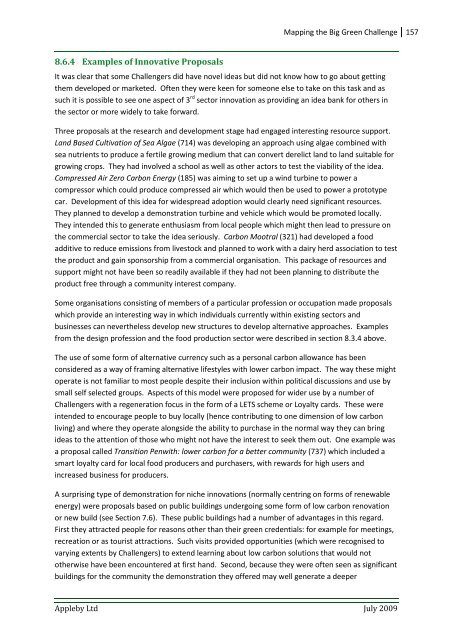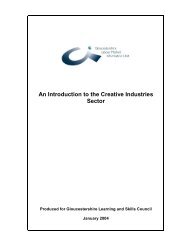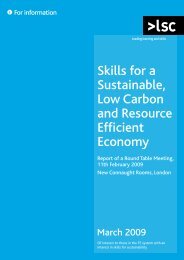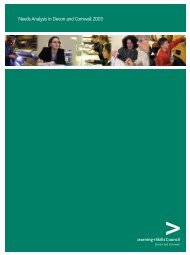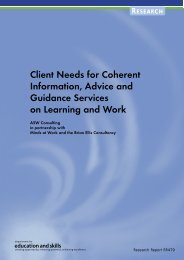Mapping the Big Green Challenge - The Skills & Learning ...
Mapping the Big Green Challenge - The Skills & Learning ...
Mapping the Big Green Challenge - The Skills & Learning ...
Create successful ePaper yourself
Turn your PDF publications into a flip-book with our unique Google optimized e-Paper software.
<strong>Mapping</strong> <strong>the</strong> <strong>Big</strong> <strong>Green</strong> <strong>Challenge</strong> 1578.6.4 Examples of Innovative ProposalsIt was clear that some <strong>Challenge</strong>rs did have novel ideas but did not know how to go about getting<strong>the</strong>m developed or marketed. Often <strong>the</strong>y were keen for someone else to take on this task and assuch it is possible to see one aspect of 3 rd sector innovation as providing an idea bank for o<strong>the</strong>rs in<strong>the</strong> sector or more widely to take forward.Three proposals at <strong>the</strong> research and development stage had engaged interesting resource support.Land Based Cultivation of Sea Algae (714) was developing an approach using algae combined withsea nutrients to produce a fertile growing medium that can convert derelict land to land suitable forgrowing crops. <strong>The</strong>y had involved a school as well as o<strong>the</strong>r actors to test <strong>the</strong> viability of <strong>the</strong> idea.Compressed Air Zero Carbon Energy (185) was aiming to set up a wind turbine to power acompressor which could produce compressed air which would <strong>the</strong>n be used to power a prototypecar. Development of this idea for widespread adoption would clearly need significant resources.<strong>The</strong>y planned to develop a demonstration turbine and vehicle which would be promoted locally.<strong>The</strong>y intended this to generate enthusiasm from local people which might <strong>the</strong>n lead to pressure on<strong>the</strong> commercial sector to take <strong>the</strong> idea seriously. Carbon Mootral (321) had developed a foodadditive to reduce emissions from livestock and planned to work with a dairy herd association to test<strong>the</strong> product and gain sponsorship from a commercial organisation. This package of resources andsupport might not have been so readily available if <strong>the</strong>y had not been planning to distribute <strong>the</strong>product free through a community interest company.Some organisations consisting of members of a particular profession or occupation made proposalswhich provide an interesting way in which individuals currently within existing sectors andbusinesses can never<strong>the</strong>less develop new structures to develop alternative approaches. Examplesfrom <strong>the</strong> design profession and <strong>the</strong> food production sector were described in section 8.3.4 above.<strong>The</strong> use of some form of alternative currency such as a personal carbon allowance has beenconsidered as a way of framing alternative lifestyles with lower carbon impact. <strong>The</strong> way <strong>the</strong>se mightoperate is not familiar to most people despite <strong>the</strong>ir inclusion within political discussions and use bysmall self selected groups. Aspects of this model were proposed for wider use by a number of<strong>Challenge</strong>rs with a regeneration focus in <strong>the</strong> form of a LETS scheme or Loyalty cards. <strong>The</strong>se wereintended to encourage people to buy locally (hence contributing to one dimension of low carbonliving) and where <strong>the</strong>y operate alongside <strong>the</strong> ability to purchase in <strong>the</strong> normal way <strong>the</strong>y can bringideas to <strong>the</strong> attention of those who might not have <strong>the</strong> interest to seek <strong>the</strong>m out. One example wasa proposal called Transition Penwith: lower carbon for a better community (737) which included asmart loyalty card for local food producers and purchasers, with rewards for high users andincreased business for producers.A surprising type of demonstration for niche innovations (normally centring on forms of renewableenergy) were proposals based on public buildings undergoing some form of low carbon renovationor new build (see Section 7.6). <strong>The</strong>se public buildings had a number of advantages in this regard.First <strong>the</strong>y attracted people for reasons o<strong>the</strong>r than <strong>the</strong>ir green credentials: for example for meetings,recreation or as tourist attractions. Such visits provided opportunities (which were recognised tovarying extents by <strong>Challenge</strong>rs) to extend learning about low carbon solutions that would noto<strong>the</strong>rwise have been encountered at first hand. Second, because <strong>the</strong>y were often seen as significantbuildings for <strong>the</strong> community <strong>the</strong> demonstration <strong>the</strong>y offered may well generate a deeperAppleby Ltd July 2009


